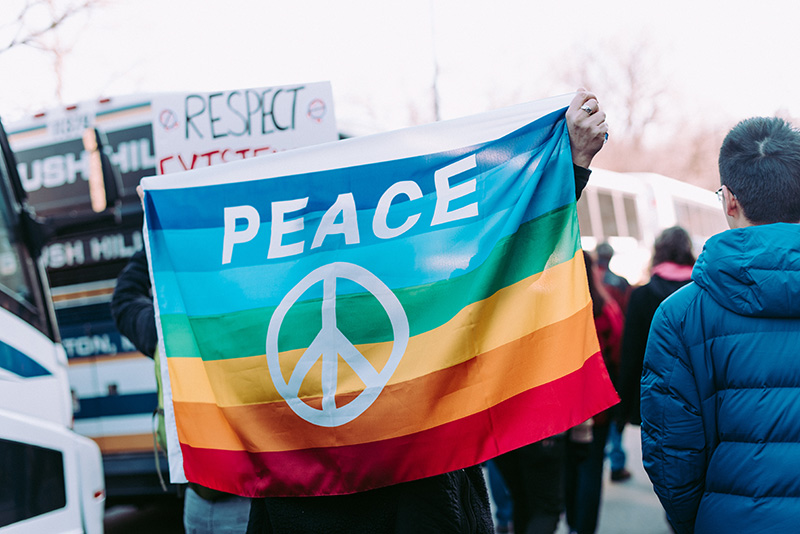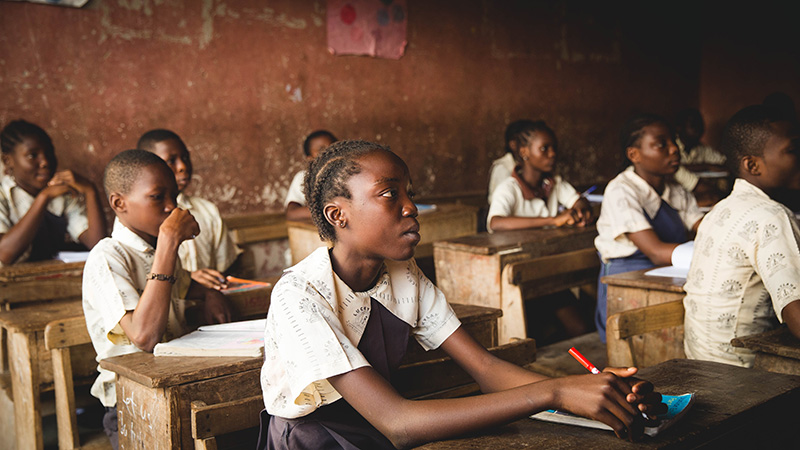Sustainable development goals aim to improve the living conditions, health, education, work conditions and ecosystems of the planet, both on land and at sea. But, as Ed Gould asks, what are they exactly and how do they function?
It was under the leadership of Ban Ki-moon, the former Director-General, that the United Nations adopted a comprehensive programme of sustainable development goals, or SDGs as they are sometimes called. They built upon a previous framework for sustainable development entitled 'The Future We Want', a non-binding commitment and product of the UN's 2012 Rio Conference. Some in the UN, including Ki-moon, saw that this was not enough and continued to press the matter.
In 2015 the UN General Assembly adopted a paper entitled 'Transforming Our World: the 2030 Agenda for Sustainable Development'. This document included a number of sections, one of which focused on sustainable development goals. There were 17 of these adopted by the UN when the paper was published.
The sustainable development goals are split up further by a number of associated targets. If each of the relevant targets is hit, so the connected goal or goals should be achieved. At the time, Ki-moon said that the sustainable development goals he wanted the world to adopt would help to ensure not only its viability but also its long-term survival: “We do not have a plan B because there is no planet B,” he memorably quipped.

Peace and justice for all: goal number 16
What are the 17 sustainable development goals?
Each of the UN-adopted sustainable development goals has a number as well as a title, which gives you a fair indication of what it's trying to achieve, even if you need to drill down a little further to understand how it will do its job. The principle behind them is that all of the countries of the Earth are signed up to similar goal-orientated aspirations:
- Goal 1 – No Poverty
- Goal 2 – Zero Hunger
- Goal 3 – Good Health and Well-Being for People
- Goal 4 – Quality Education
- Goal 5 – Gender Equality
- Goal 6 – Clean Water and Sanitation
- Goal 7 – Affordable and Clean Energy
- Goal 8 – Decent Work and Economic Growth
- Goal 9 – Industry, Innovation and Infrastructure
- Goal 10 – Reduced Inequalities
- Goal 11 – Sustainable Cities and Communities
- Goal 12 – Responsible Consumption and Production
- Goal 13 – Climate Action
- Goal 14 – Life Below Water
- Goal 15 – Life on Land
- Goal 16 – Peace, Justice and Strong Institutions
- Goal 17 – Partnerships for the Goals
Although when they're described by their headlines only, some of the sustainable development goals can sound a little wishy-washy, as soon as you look at the principles behind them, you can see what each is trying to achieve. For example, climate action is described as: “Taking urgent action to combat climate change and its impacts by regulating emissions and promoting developments in renewable energy.”
Likewise, the second SDG of 'Zero hunger' is set to be achieved by improving food security measures and by promoting a more sustainable form of agriculture.
“We do not have a plan B because there is no planet B.” Ban Ki-moon talking about Sustainable Development Goals
Although some critics have pointed out that some of the sustainable development goals might impinge upon one another – for example, improved infrastructure projects might make life on land less sustainable – the key to the approach taken by the UN is the international way in which sustainable development must be undertaken in the future.
After all, the entire global population's well-being, happiness – and even its survival – may require greater cooperation among the people of the world to ensure the planet is fit to live on for centuries to come. Essentially, the sustainable development goals try to offer a blueprint as to how all countries should regulate their citizens and organizations in order to do the best by the planet and its people.

Doctor's orders: good health and well-being is another goal
Why were sustainable development goals created?
With increasing worldwide trade, many considered that globalization could have a negative impact on those people around the world who could not access its benefits. In addition, it was thought that an international approach to solving sustainable social and economic development was required in the post-Kyoto Accord world. This was due to the perception that as burgeoning economies around the planet were making great strides, they might be doing so without necessarily working with all of the regulatory safeguards that more established industrial economies have in place.
Ultimately, the 17 sustainable development goals were developed in order to try and create a better future and more sustained happiness. As such, the proposals started to be acted upon by as early as 2016.
How are sustainable development goals implemented?
In just about every country of the world, individuals, educational institutions, governments, local authorities and non-governmental organisations have been taking on all kinds of work on the sustainable development goals that are relevant to them. As you might expect, the greatest responsibility for action plans resides with national governments. The governments of each country must translate the goals into a legislative framework which all businesses and individual citizens need to comply with.
Furthermore, a national plan of action must be developed with establishes targets against any budgetary considerations. Part of the final sustainable development goal is to promote international action, and this can be seen in the way that richer countries are encouraged to seek out partners. This is because it was thought from the outset that poorer countries would need the support of more affluent nations in order meet all of their commitments under the programme.
“The entire global population's well-being, happiness – and even its survival – may require greater cooperation among the people of the world to ensure the planet is fit to live on for centuries to come.”
It's fair to say that not all of the burden of meeting sustainable development goals comes down to the actions of individual governments. The Council of the Baltic Sea States decided to make their plans in cooperation with one another and published their proposed actions in a document known as the Baltic 2030 Action Plan, for instance.
In India, a policy think tank, known as the National Institution for Transforming India, was charged with coming up with many of the proposals that would see the country meet its ongoing SDG commitments. However, individual states within India have already begun implementing their own proposals in a way that's relevant to their particular circumstances and needs. As such, implementation of sustainable development goals is very varied, operating at both the sub and supranational state levels.

Goal 4: quality education for all
Who uses sustainable development for their goals?
Despite the good work that's already underway with SDGs around the world, there is some variation with its take-up so far. According to the World Economic Forum (WEF), countries like Canada, the UK, France, Germany, Italy, Australia and New Zealand are all performing quite well. That organization gave all countries which were signatories to the UN programme an index rating between zero and 100 to better judge its actions by.
As you might expect, these countries and others like them, such as Spain, Japan and Denmark, were all categorised as 70 or above. When they measured their performance across all 17 goals – some which they might have been meeting due to EU policy directives anyway, thereby giving them a head start over other countries – European countries did especially well. Sweden was found to be the best-performing nation with an index of 84.5. Canada was the top country outside of the EU, in 13th place with an index of 76.8.
RELATED: Social justice isn't just for superheroes
Equally unsurprisingly, the war-torn Central African Republic and troubled Liberia were at the bottom of the WEF's list of achievers with sustainable development goals. In fact, with the exception of Haiti and Afghanistan, they found that nearly all of the lowest-achieving countries were in Africa. As such, the WEF has called for international mechanisms to come into effect that will assist those at the bottom of the pile to meet their commitments by the programme's deadline of 2030. That organization suggested direct foreign investment, technology sharing and a tranche of global tax reform measures as ways forward.
Among the key players in any UN-sponsored global programme is inevitably the United States. According to the UN's own information, the US has taken a large number of steps toward fulfilling its commitments, not least with a statewide sustainability programme for the whole of Hawaii.
In addition, US schemes like the Bridge Initiative have sought to improve social and economic development across several sub-Saharan countries. Despite these measures – and more – the US still ranks as only a middling performer among countries, according to the WEF. At the UN, it's hoped that one of its major partners in many areas of international cooperation will see a dramatic improvement when it comes to sustainable development goals prior to the 2030 deadline which moves ever closer. ●
happiness.com | The fine art of being: learn, practice, share
Are you a happiness.com member yet? Sign up for free now to:
■ enjoy our happiness magazine with practical life tips
■ share and support others in our happiness forum
■ learn with free online classes in our happiness Academy
Written by Ed Gould
 Ed Gould is a UK-based journalist and freelance writer. He is a practitioner of Reiki.
Ed Gould is a UK-based journalist and freelance writer. He is a practitioner of Reiki.




Join the conversation
You are posting as a guest. If you have an account, sign in now to post with your account.